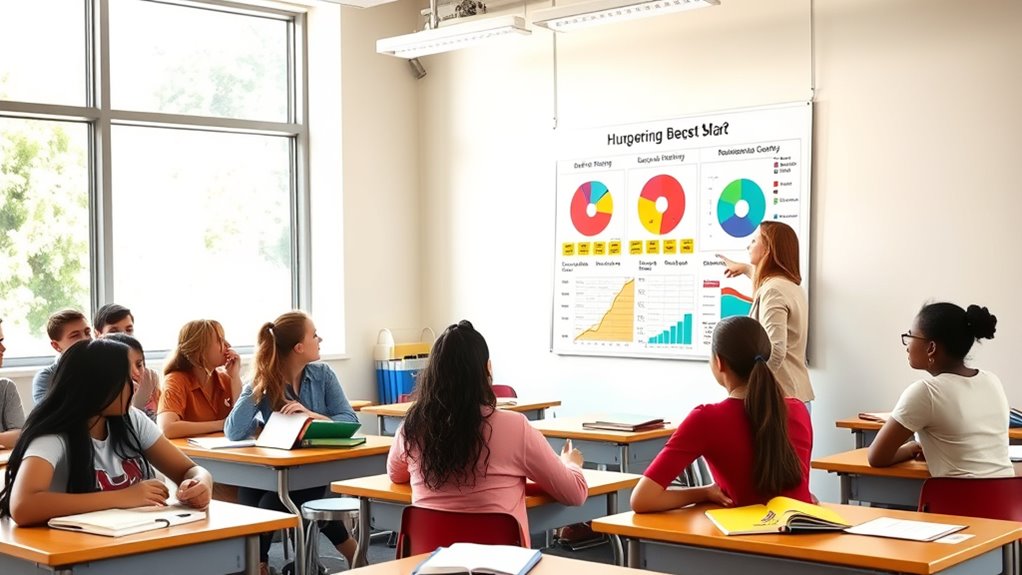Integrating life skills and financial literacy into school curricula prepares you for real-world challenges. These skills help you evaluate online information, protect personal data, manage emotions, and handle money confidently. When these skills are part of your education, you become more adaptable, resilient, and better equipped to navigate social media, finances, and conflicts. If you want to discover how schools can better equip students for everyday life, keep exploring further.
Key Takeaways
- Integrating life skills and financial literacy enhances student preparedness for real-world challenges beyond academics.
- Including these skills in curricula fosters decision-making, emotional intelligence, and digital safety.
- Addressing current barriers, such as standardized testing focus, can facilitate effective curriculum integration.
- Teaching financial literacy helps students develop responsible money management and financial independence.
- Incorporating these skills promotes holistic development, resilience, and adaptability in a rapidly changing environment.

Have you ever wondered why life skills and financial literacy aren’t prioritized in school curricula? It’s a question many people ask as they realize how vital these skills are in everyday life. Schools tend to focus heavily on academic subjects like math, science, and language arts, often overlooking what it truly takes to navigate the complexities of real-world situations. Yet, in today’s digital age, mastering digital literacy and emotional intelligence is just as important as traditional subjects. Digital literacy enables you to critically evaluate information online, protect personal data, and stay safe in a world where technology is intertwined with daily activities. Without it, you risk falling prey to misinformation or cyber threats, which can have serious consequences.
Emotional intelligence, on the other hand, helps you understand and manage your feelings, communicate effectively, and build healthy relationships. It’s the backbone of resilience and empathy, skills that are essential both professionally and personally. When schools neglect to teach these areas, students might excel academically but struggle when facing real-life challenges like conflict resolution, stress management, or adapting to change. Incorporating lessons on digital literacy ensures you are prepared to navigate social media, online banking, and digital communication confidently and responsibly. Meanwhile, emphasizing emotional intelligence helps you develop self-awareness and empathy, making you more effective at teamwork and leadership. Additionally, understanding vetted products for safety can help parents choose appropriate tools and resources for their children’s well-being.
The reason these skills aren’t prioritized often lies in the traditional education system’s focus on standardized testing and academic achievement. It’s easier to measure progress through test scores than it is to gauge emotional intelligence or digital literacy. However, neglecting these skills leaves gaps that can’t be filled by textbooks alone. For example, you might understand financial concepts but struggle to apply them because you’re uncomfortable discussing money or managing financial stress. Or you might have technical skills but lack the emotional intelligence to handle workplace conflicts or support colleagues effectively.
Incorporating life skills and financial literacy into school curricula doesn’t mean replacing core subjects; it means supplementing them to prepare you better for life beyond school walls. When you develop digital literacy and emotional intelligence alongside academic knowledge, you’re more equipped to handle the unpredictable, fast-changing world. Ultimately, these skills empower you to make smarter decisions, build meaningful relationships, and adapt to whatever challenges come your way. Schools that recognize this shift are setting students up not just for academic success but for lifelong resilience and well-being.
Frequently Asked Questions
How Are Life Skills and Financial Literacy Assessed in Schools?
You’re assessed on life skills and financial literacy through a mix of standardized tests and student portfolios. Standardized tests evaluate your understanding of key concepts like budgeting or decision-making, while portfolios showcase your practical skills, such as creating a budget plan or reflecting on real-life scenarios. This combination helps teachers gauge your ability to apply what you’ve learned in real-world settings, ensuring you develop essential skills for life.
Which Countries Have the Most Comprehensive Curricula for These Skills?
You’ll find that countries like Australia, Canada, and Singapore lead with all-encompassing curricula that integrate life skills and financial literacy, aligning with global best practices. These nations prioritize curriculum integration, embedding essential skills across subjects rather than isolating them, ensuring students develop practical knowledge. By adopting such approaches, they prepare students for real-world challenges, making their education more relevant and effective in fostering responsible financial behavior and essential life skills.
How Do Teachers Receive Training to Teach Life Skills and Financial Literacy?
You receive training through teacher professional development programs focused on curriculum integration. These programs equip you with essential skills to teach life skills and financial literacy effectively, often involving workshops, online courses, and collaborative planning sessions. Schools and educational authorities design these initiatives to guarantee you understand both content and pedagogical strategies, helping you confidently incorporate these crucial topics into your lessons and prepare students for real-world challenges.
What Role Do Parents Play in Reinforcing These Skills at Home?
You might think schools alone shape your child’s financial smarts, but parental involvement truly makes the difference. By actively engaging in conversations about money, budgeting, and decision-making, you reinforce what they learn at school. Home reinforcement helps your child develop confidence and responsibility. So, don’t underestimate your role—you’re the real teacher when it comes to life skills. Your involvement creates a lasting impact that classrooms alone can’t achieve.
Are There Digital Tools or Resources to Supplement Classroom Learning?
You can use interactive platforms and mobile applications to supplement classroom learning. These digital tools make financial literacy and life skills engaging, allowing you to practice real-world scenarios and reinforce concepts learned in school. By exploring these resources together, you can build confidence and understanding outside the classroom, making learning more flexible and fun. Many apps also offer personalized feedback, helping you track progress and stay motivated.
Conclusion
Incorporating life skills and financial literacy into school curricula isn’t just about lessons; it’s about planting seeds for your future. When you learn to manage money and navigate life’s challenges early on, you’re building a sturdy foundation—like a tree growing strong in the same soil. As you walk through life’s unpredictable paths, these skills become your steady compass, guiding you safely home. It’s all about preparing you for the moments that matter most.









